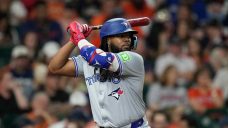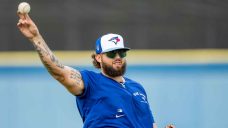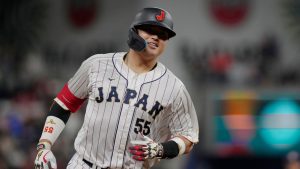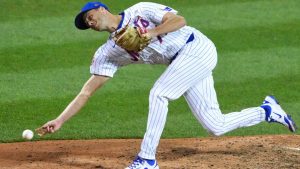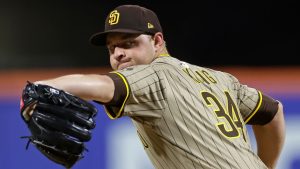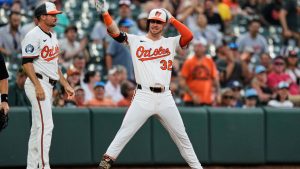For the Blue Jays to be successful this season, they’ll need production from right-handed hitting. There’s no way around it. George Springer, Vladimir Guerrero Jr., Bo Bichette, Justin Turner, Alejandro Kirk, Danny Jansen — this team’s biggest offensive threats all hit from the right side.
The league is obviously aware of that. And through Toronto’s first two series against the Tampa Bay Rays and Houston Astros, we saw a glimpse of how opponents will seek to neutralize all those Blue Jays righties.
The Rays executed a clear strategy to attack the outer third of the plate, particularly up-and-away. Here’s a heat map of where Toronto’s right-handed hitters were pitched in that season-opening series:
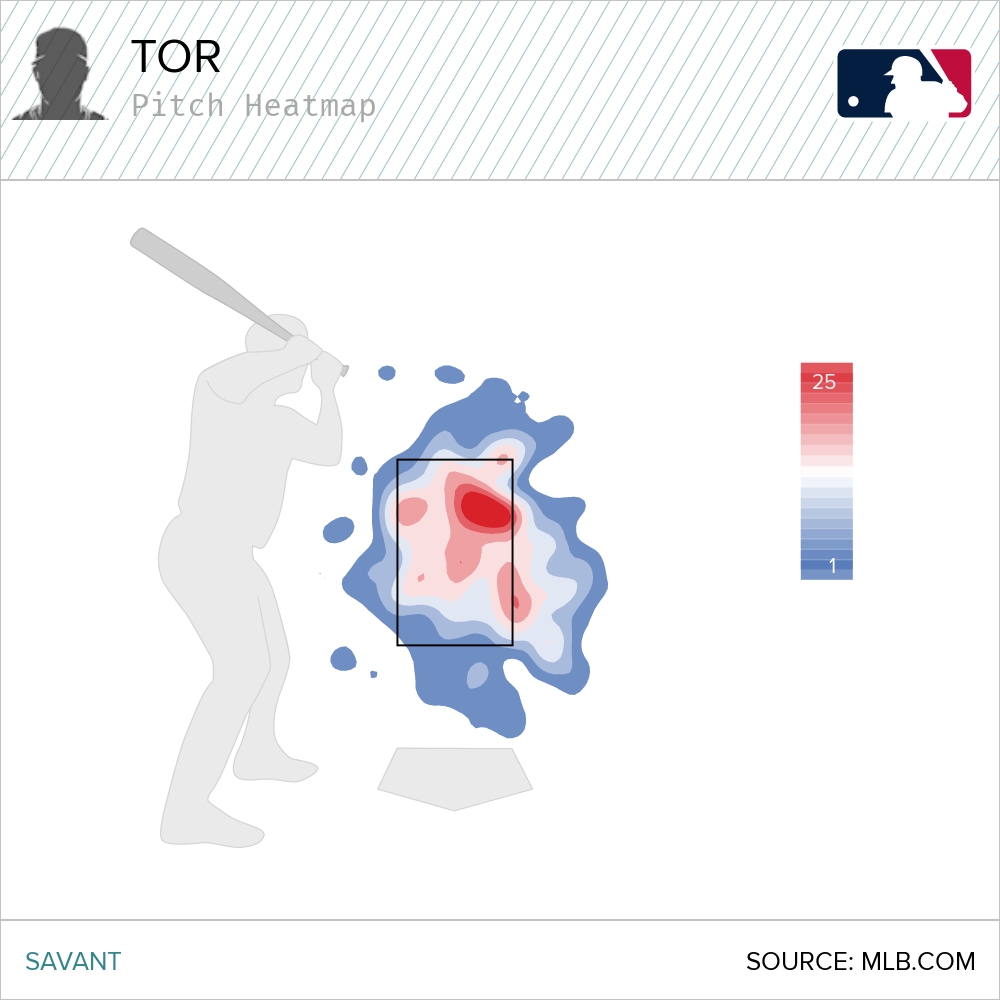
In light of the Blue Jays frequently declaring an intent to be more selective this season, narrowing their zones to attack the pitches they can best do damage against while letting ones they can’t go by, Tampa’s strategy makes sense. If Toronto’s right-handers were going to wait for something middle-in they could drive to the pull side and give opponents strikes along the outside black, the Rays were going to try to take them.
So, over the course of the series, Tampa pitchers located over 43 per cent of the pitches they threw to right-handed batters on the outer third of the plate and beyond, as defined by Baseball Savant’s attack zones. And they earned a strike with 52 per cent of them.
Blue Jays righties did what they could to stick with their approach, laying off 62 per cent of those pitches and earning a ball the majority of the time that they did. They walked 10 times on pitches that missed off the outside edge. The Blue Jays will take that all day.
But they also put 24 of those offerings in play and came away with only four hits: three singles and Springer’s Opening Day solo shot. Mix in 11 strikeouts and you get a .114/.311/.200 line against those outer-third pitches. The margins are thin over only four games but this was nevertheless a factor in the series. Execute a bit better, cut down a swing to flip one or two of those balls into right field, and maybe we’re having a different discussion.
Now, pitching away from righties isn’t exactly a novel approach. And hitters are never going to see particularly great results swinging at pitches moving towards the end of their bats. But Blue Jays right-handers still batted .231/.319/.321 against those outer-third-and-beyond pitches in 2023, which stands in stark contrast to how they performed over four games against the Rays. And with the Blue Jays seemingly hunting inner-third pitches that would allow them to tap into their pull power, this may have been the perfect time for the Rays to double down on that attack plan.
Ultimately, it seems the Rays were content to live with the free passes they gave up in order to stay away from the parts of the plate where Toronto hitters were looking to do damage. That worked in the middle games of the series when Toronto scored only three times; not so much in the opener and finale when the Blue Jays got big swings with runners on and piled up 17 runs.
It’s easy to forget after the woeful Astros series, but Blue Jays hitters did prove at Tropicana Field that their approach can play if they don’t deviate from it and execute in the run-scoring opportunities it presents. The production in the two games the Blue Jays won came from being discerning, taking walks, waiting for Rays pitchers to come in to them, and driving a ball when they did. The lack of production in the two games they lost was a result of the final piece of that sequence being absent.
Meanwhile, the Astros presented a similar attack plan to the Rays but added another layer, staying on that outer third while starving Blue Jays right-handed hitters of the fastballs they’re trying to do damage against. After Toronto righties saw 70 per cent fastballs in the Rays series — including four-seamers, two-seamers, and cutters — that rate plummeted to 35.3 per cent against the Astros, who threw them a slider or changeup half the time:
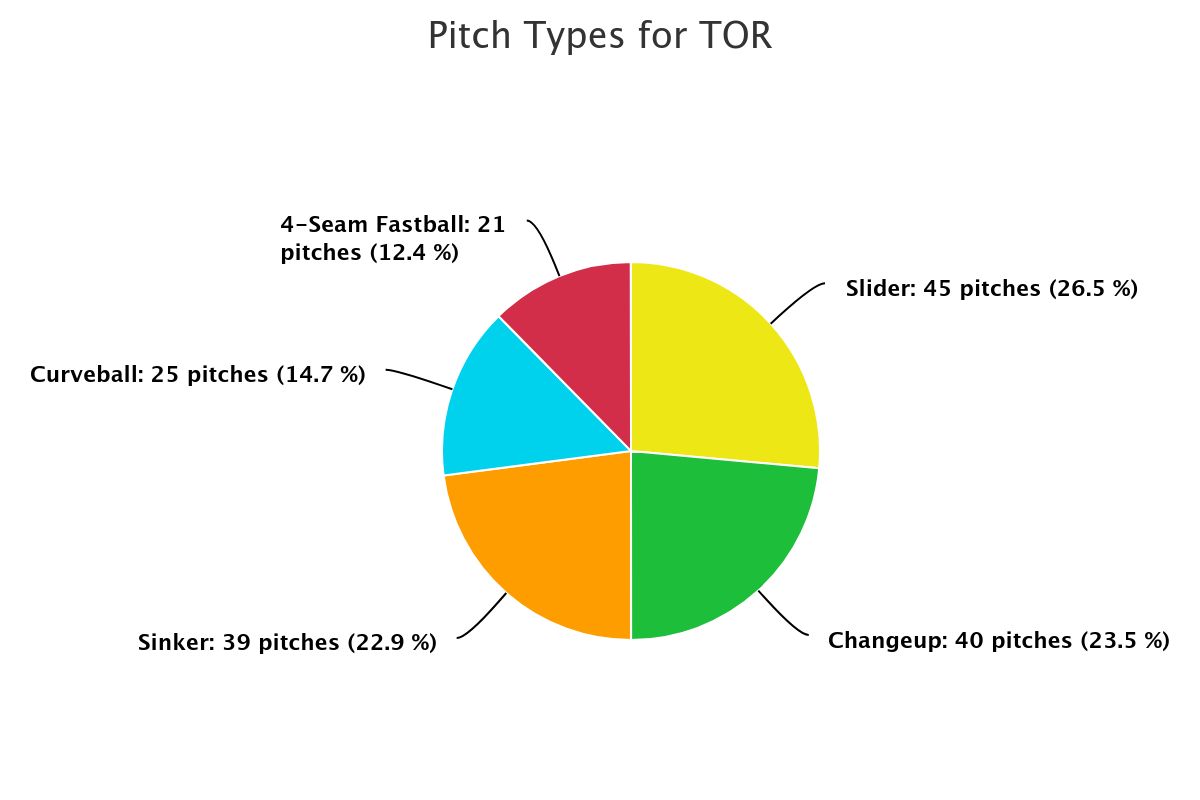
Springer made 12 plate appearances in the series and saw 24 pitches — only four of them were fastballs. Guerrero saw 30 pitches over his dozen plate appearances. Just 13 were heaters. Kirk saw nine fastballs in the series while playing nearly every inning; Bichette saw six fastballs in his two games.
No doubt, part of this was Astros starters Ronel Blanco, Framber Valdez, and Cristian Javier leaning into their strengths. Blanco, in particular, leads outings with his slider or changeup. But Valdez has always worked off his sinker while Javier threw nearly 60 per cent fastballs last season. It’s fair to assume part of the approach was a specific plan against Blue Jays hitters, as well.
And it worked. The Astros nullified Blue Jays right-handed hitting in the series, holding it to a .125/.222/.203 slash line across the three games. The Blue Jays got only eight hits from righties in the series — five of them singles — with Davis Schneider’s game-winning drive off Josh Hader on Tuesday the loudest by far. Put that unlikely homer off a hanging mistake slider from one of the game’s elite closers aside and the only extra-base hits you’re left with are a pair of Turner doubles off Valdez.
This is all small sample stuff, as everything is a week into an MLB season. But the Rays and Astros have been among MLB’s elite teams over the last decade because their analysts distill information, their coaches strategize approaches, and their pitchers execute gameplans as well as anyone. And they likely just showed Toronto a couple ways teams will try to contain the right-handed hitters their offence relies upon this season. Now, it’s up to the Blue Jays to adjust.
The Orioles remain a problem
You know, I was being earnest when I wrote two weeks ago that the Norfolk Tides — Baltimore’s triple-A team — would be a really fun watch in 2024. Here’s their box score from Wednesday night against the Charlotte Knights:
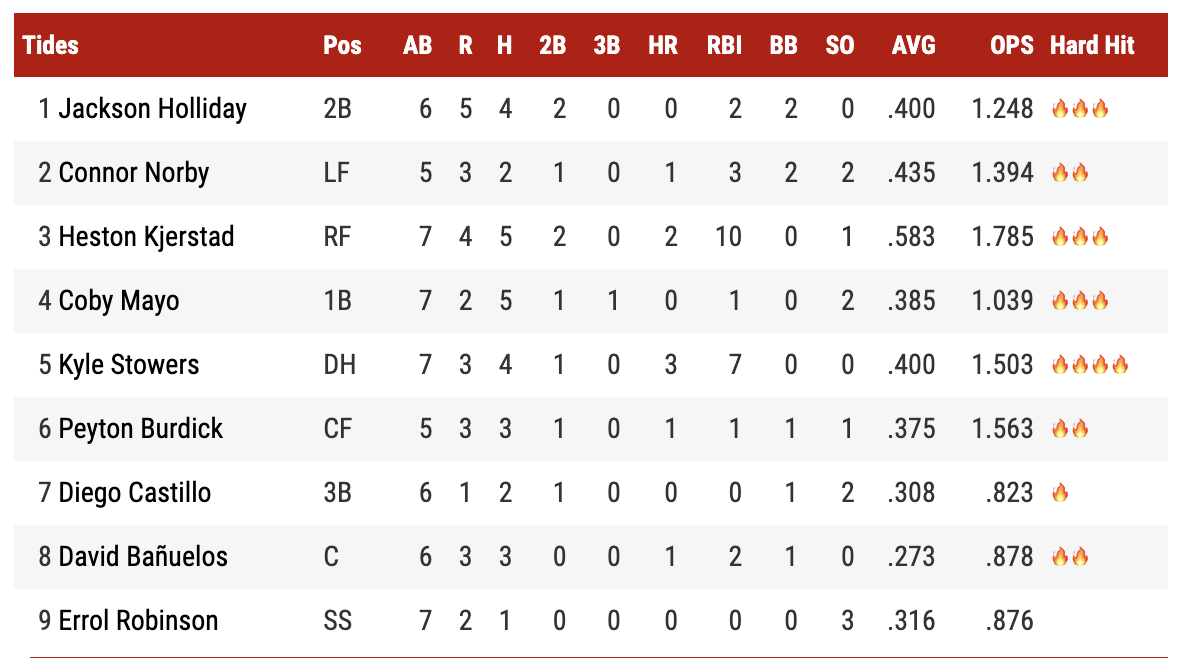
Norfolk scored 26 runs on 29 hits and seven walks that night. They plated a runner in all but one of the game’s nine innings. They put 13 balls in play at 100 m.p.h. or harder. They drove seven pitches 380 feet or farther. They hit eight home runs, nine doubles, and a triple.
Jackson Holliday — MLB’s top prospect who should’ve been playing for the Orioles on Opening Day — reached base six times in eight trips. Heston Kjerstad — a .314/.388/.527 minor-league hitter with power to all fields — had two doubles and two homers as part of a five-hit night. Kyle Stowers — a likely every-day player on the Rockies who the Orioles don’t have room for in the majors — went deep three times. Coby Mayo — a consensus top-30 MLB prospect who lands only third or fourth in Baltimore’s organizational rankings — had five hits including two for extra bases.
And they’ve been playing arcade baseball all week. Norfolk has plated nine runs or more in five of its first six games. They’re batting .362/.428/.761 as a team. Kjerstad has 16 hits through those six games. Stowers, Holliday, and Mayo have 11 each. Connor Norby — a 23-year-old who rarely even gets mentioned in Orioles prospect chatter despite hitting 50 homers across his first two full minor-league seasons — is batting .393/.438/.821.
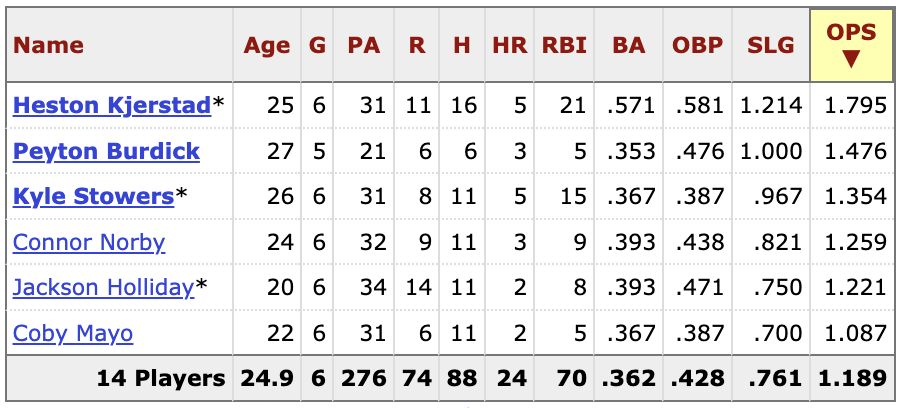
For an Orioles organization coming off a 101-win season and AL East title, while currently running out lineups dotted with young, homegrown contributors like Adley Rutschman, Gunnar Henderson, Jordan Westburg, and Colton Cowser, to have this much talent buried on its triple-A roster is ludicrous.
Whether these players force their way to the majors this year on merit, spend time mid-season filling in for injured big-leaguers, or end up traded to bolster Baltimore’s still inadequate pitching staff, they’ll contribute in some way to the Orioles continuing to be a force in the division the Blue Jays play in. This season and likely for many to come.
For Jays offence, it won’t get any easier
Remember when the Blue Jays played the Red Sox on the final weekend of the 1978 season? Of course you do. Jim Clancy got rocked in the opener as the Red Sox scored 11 without hitting a home run. Jim Rice capped his MVP season with four hits and three walks in the series. Neither team used a reliever in the final two games.
Anyway, this week’s offensive performance in Houston was Toronto’s worst since that weekend at Fenway Park when Don Mattingly was still in high school:
Fewest hits & lowest batting average by Blue Jays in a series of three-plus games
Tough to score runs without many hits, which is one reason the Blue Jays have averaged 3.14 runs per game through the first week of the season. In 2023, the Oakland Athletics averaged the fewest runs per game of any team in the majors with 3.61. That’s really all you need to know about how things have gone for Toronto’s offence so far. This is a team that needs to find a way to be more productive going forward.
And yet, the 3-4 Seattle Mariners have an identical run differential to the Blue Jays (-14) while averaging 2.14 runs per game over their first seven. But Toronto’s early-season struggles are just a continuation from last year! Well, Seattle had a worse offence in 2023 than the Blue Jays did by batting average, on-base percentage, slugging percentage, strikeout rate, etc., etc. Meanwhile, the sky doesn’t seem to be falling in Seattle quite like it is in Toronto.
We’ll be able to play Mickey Mouse games like these with early-season statistics for weeks to come. We’ve all seen baseball seasons before. It takes a while for results to normalize and a clearer picture to emerge of what a team is and what it isn’t. A bad week in early April just stands out more starkly than one in mid-summer.
The Philadelphia Phillies started last season 1-5 with a -24 run differential and went to the NLCS. The Arizona Diamondbacks started 3-4 with a -17 and beat those Phillies to move on to the World Series. The Texas Rangers won a championship after going 13-18 — a .419 winning percentage! — over six weeks from June 24 through the end of July. Then they lost eight straight in August.
Meanwhile, quicker-to-stabilize peripheral indicators such as strikeout rate (the Blue Jays have the seventh-lowest across MLB), walk rate (Toronto’s is third-highest), whiff rate (eighth-lowest), and chase rate (seventh-lowest) are right there if you’re looking for them. Toronto hitters have seen a 2-0, 3-0, or 3-1 count in a third of their plate appearances thus far, which ranks fourth across MLB. And their batting average on balls in play is dead last at .196.
Ultimately, Toronto’s offensive woes have come down to execution. The Blue Jays are taking balls, getting into favourable counts, swinging at strikes, and making contact. They just haven’t squared up that contact consistently enough to get good outcomes on balls in play. If the process remains the same, and the execution improves, Toronto’s offence ought to fare better over time. That’s what the sport’s history tells us. If the process is steady, but the execution remains as poor as it’s been, the Blue Jays will lose more games than they win. That’s what we’ve seen so far.
Of course, Toronto hitters and coaches can’t sit around and wait for better results to happen. The Blue Jays need to adjust to the well-crafted gameplans the Rays and Astros deployed against them to turn this brief skid around quickly before it becomes a prolonged slump. The problem is the quality of competition isn’t about to ease.
The Blue Jays play three in the Bronx this weekend where they’ll face Marcus Stroman, Clarke Schmidt, and Luis Gil along with a Yankees offence that has been just as good — and in most cases better — as Toronto’s in all of those process stats above. The difference is the Yankees are executing and getting results, averaging 4.6 runs per game over their first seven.
After that? It’s finally home to welcome those similarly scuffling Mariners who are trending towards starting Luis Castillo, George Kirby, and Logan Gilbert — three pitchers you could make convincing Cy Young cases for.
This is life in the most competitive division of the most competitive league in the world. It’s never going to be easy. But if the Blue Jays are going to quickly course-correct after a challenging three games in Houston, they’ll have to find a way amidst some very tough resistance.
